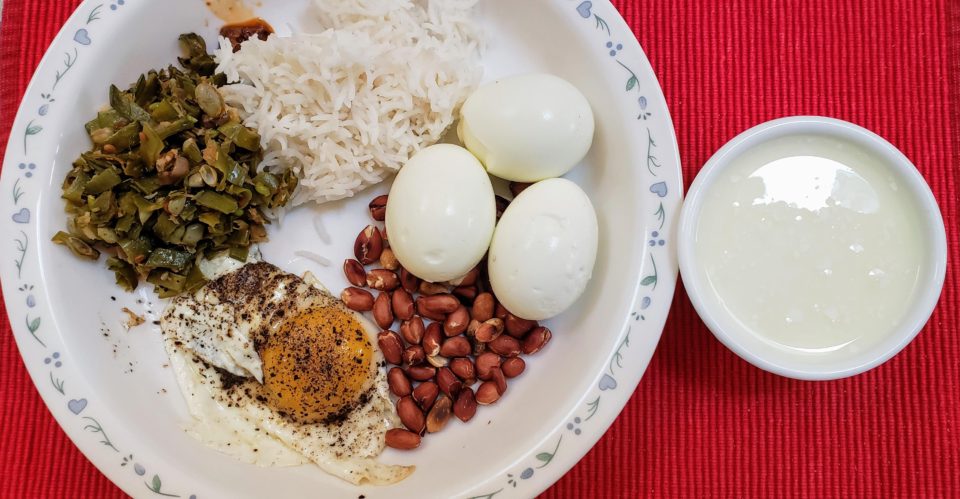The diet plan I worked out for weightloss
Continuing from where I left off – Beach Body with six pack at 47 years of age? Is It doable? The simple mantra I followed for weight loss – Weight loss is calorie management + Hormone management + macro management. I worked out a diet based on this mantra. What I follow and advise others is – Do not set targets for weight loss as it puts pressure on oneself causing the stress in itself. Weight Loss need to happen, not in isolation, but while going through the every day normal activities like office work etc as we do not have the luxury of a weight loss in isolation unlike some celebrities. Ideally aim for 2 pounds or less per week of weight loss if you are obese and if you are healthy, aim for 1 pound per week to cause the body instabilities (feeling hungry all the time, tired, unable to concentrate on regular everyday activities). And workout a diet which aligns with your current cultural aspect of the diet. I am a Tamilian and I incorporated the diet using my Tamilian dietary preferences – e.g. South Indian filter coffee, rice with yoghurt (curd) so I can sustain the diet as a lifestyle change.
- Calorie deficit causes weight loss but avoid more than 500 calories deficit per day
- Calories required per day = resting metabolic calories + non-exercise activities + exercise activities
- Count the macros in the diet you eat (grams of carbohydrates, proteins and fat) and keep carbohydrates to less than 150 gm. I suggest starting at 225 grams and if you do not seeing a weight loss in 2 weeks, reduce it gradually to 200 grams. If you are seeing a weightloss, do not reduce it. You want to cut down carbohydrates to try breaking the weight loss plateau.
- Carbohydrates per gram provide 4 calories of energy, protein – 4 calories per gram, fat – 9 calories per gram. So calculate the grams vs calories accordingly
- Whatever the carbohydrates one eat should be from complex carbohydrates and not simple carbohydrates or sugars. Simple vs complex carbohydrates are decided by the glycemic index numbers and insulin index numbers.
- Glycemic index – focus on blood sugar levels attributed mainly to carbohydrates. I.e. High glycemic carbs will spike the blood sugar levels quickly. Low Glycemic carbs will be slow digesting and would not spike the blood sugar levels quickly. E.g. – Wheat, Multi-grain, Sourdough breads, Basmati rice, many fruits, vegetables etc.
I avoided any carbohydrate food source with a glycemic index of 59 or above. For reference to Glycemic index of a food – https://www.glycemicindex.com/index.php
- Insulin index – to keep it simple, a food can belong to any food group(carb, protein and fat) or a mix of all 3 food groups but can spike the insulin hormone in the body. For the same Glycemic index, 2 foods can trigger different insulin levels. Low Insulin index foods are full fat yoghurt, whole eggs, whole milk etc. High Insulin index foods are potatoes, fat free milk, yoghurt etc – https://en.wikipedia.org/wiki/Insulin_index
- I used for some carbs, glycemic load but I will ignore it from the article for now
- Say “no” to alcohol.
- Avoid snacks etc
- Fats (cholesterol including) is good. But fats should be from naturally occurring sources – ghee, eggs, whole milk, whole milk yoghurt, cheese, nuts, avocados etc are good natural sources of fat.
- Avoid Fat-free foods like skim milk, 0% yoghurt etc
- One should consume protein every day at .5 gm per pound (1 gm per kilo) of one’s weight as proteins are essential for body processes and also for the upkeep fo the muscles.
- Protein can be from vegetarian sources or non-vegetarian sources but should have the 9 essential amino acids (there are a total of 20 amino acids in the human body) . Food sources like eggs are wholesome protein in that it provides the 9 essential amino acids. Many vegetarian sources will not provide wholesome protein but a combination of sources provide the 9 essential amino acids. For example, almond nuts and garbanzo beans are not wholesome protein but the combination of these 2 provide the essential amino acids
- Take supplements such as zinc, magnesium, Vitamin D (5000 IU per day), multi-vitamins, Ashwaganda ayurvedic powder/capsule
- Avoid other sports supplements as many of the supplements are not FDA regulated and might have some other hidden chemicals
With these guidelines/rules above,
- Taking a google sheet, I worked out the breakfast, lunch, dinner which I normally eat and started the calorie count, macros in gms and worked out a plan. My diet calorie per day is roughly equivalent to the resting metabolism (link for resting metabolism – I use Tanita Body composition monitor which gives resting metabolism)
- Calorie deficit would come from non-exercise activities like walking to office, cleaning the house,- etc and exercise related activities like weight training, HIIT, cardio etc
- There are apps like which do calorie, macro calculations for you. I briefly used 1 before I wanted more control on my calculations instead of relying on default calorie settings provided by the app. I googled for the calories for various foods and did a rough estimate on the gms (I have food weighing scale and used it too)
Breakfast Plan
Adjusted the carbohydrates to remove simple carbohydrates like white bread, orange juice and replaced them with complex carbohydrates like sourdough bread toasted with butter, vita coco coconut water etc.
Adjusted the carbohydrates grams to around 150-170 gm per day.
My only indulgence was the South Indian filter coffee which I drink with whole milk and 1 teaspoon of sugar which is equivalent to roughly 5 gm of carbohydrates which in the bigger scheme of things does not count much or does not do much damage to the body.
Lunch Plan
I took my South Indian comfort food of rice with curd (yoghurt) or sambhar and vegetables and adjusted the plan
- Replaced the yoghurt with a cup of whole milk yoghurt
- Replaced the rice with low glycemic rice – basmati and limited in quantity
- Vegetables – I left out potatoes and included the regular vegetables I eat
- Added 50 gm of peanuts for good fat
- Added a whole egg and 3 egg whites ( whole eggs are good but I wanted more proteins and less fat to get a balance the total calories per day)
- Added a small pickle
- A small raw cucumber for rehydration

Dinner Plan
- Added 2 whole wheat chapatis (made at home – so I know these are complex carbs with no other additions)
- 2 whole eggs and 2 eggs whites (can be swapped with a combination of veg protein sources to get essential amino acids)
- A small cucumber
- A packet of vita coco coconut water packet
So in summary, here is the diet plan I used (for now ignore the training tab)
| Diet & Nutrition | ||||
| breakfast | calories | carb gm | protein gm | fat gm |
| Sour Dough Bread – 1 slice | 130 | 17 | 6 | 2 |
| eggs – 2 | 160 | 12 | 10 | |
| Whole Milk in coffee (around 1/8 cup + sugar (1 pack) | 20 | 9 | 2 | 2 |
| coconut water (vita coco) – 1 | 60 | 15 | ||
| 1 banana | 100 | 27 | 1 | |
| butter 1/2 tablespoon | 54 | 4 | ||
| Lunch | ||||
| Yoghurt – 1 small cup (full fat) | 150 | 12 | 9 | 8 |
| Basmati (~ 1/4 cup) | 50 | 11 | 1 | |
| egg whites (3) | 51 | 12 | ||
| 1 cucumber (mini) | 8 | 4 | 1 | |
| peanut (50 gm) | 270 | 12 | 8 | 25 |
| Vegetables | 49 | 12 | 3 | |
| egg – 1 whole | 80 | 6 | 5 | |
| Dinner | ||||
| Chappati (2) | 200 | 30 | 6 | |
| egg (2 whole eggs) | 160 | 12 | 10 | |
| dal (l~ 1/4 cup) | 50 | 8 | 3 | |
| egg (2 egg whites) | 34 | 8 | ||
| vegetables | 49 | 12 | 3 | |
| 1 cucumber (mini) | 8 | 4 | 1 | |
| Total | 1683 | 173 | 94 | 66 |
How do I manage when I travel?
When I travel which I do once in 2 weeks, I can mimick my daily breakfast easily. For lunch and dinner, I know my alternate sources are chicken for protein (100 gm of chicken provides 30 gms protein). I would either pair the chicken with basmati rice+dal+veggie salads or chicken sandwich without the bread (or whole wheat bread) + veggies. In summary, I err on the side of less calories eaten than my usual. The variations in the food calories reduces the chances for weight loss plateau. For Vegetarians, one can easily pair couple of food sources, for example, almonds with garbanzo beans to achieve a good source of protein with all essential amino acids.
Do I do cheat meals?
I tend to avoid cheat meals though cheat meals with good calories and avoiding simple sugars mostly will help in boosting the good hormone, leptin, which signals the brain that there no further need to eat as the body has enough fats to draw the energy from preventing one from overeating.
.
How did I work out these details above?
To workout the dettails above, I researched on the
- Hormones involved in the weightloss and their impact
- Internal mechanism of how stored fat is used by the body and efficient use of the stored fat for energy
- Bodily functions of various macros – fat, protein, carbohydrates
I will publish a detailed article on the above items as understanding these 3 items would crack the weightloss code…. Till then……..
Related Articles –


Can i take Ashwagandha capsule during intermittent fasting period?